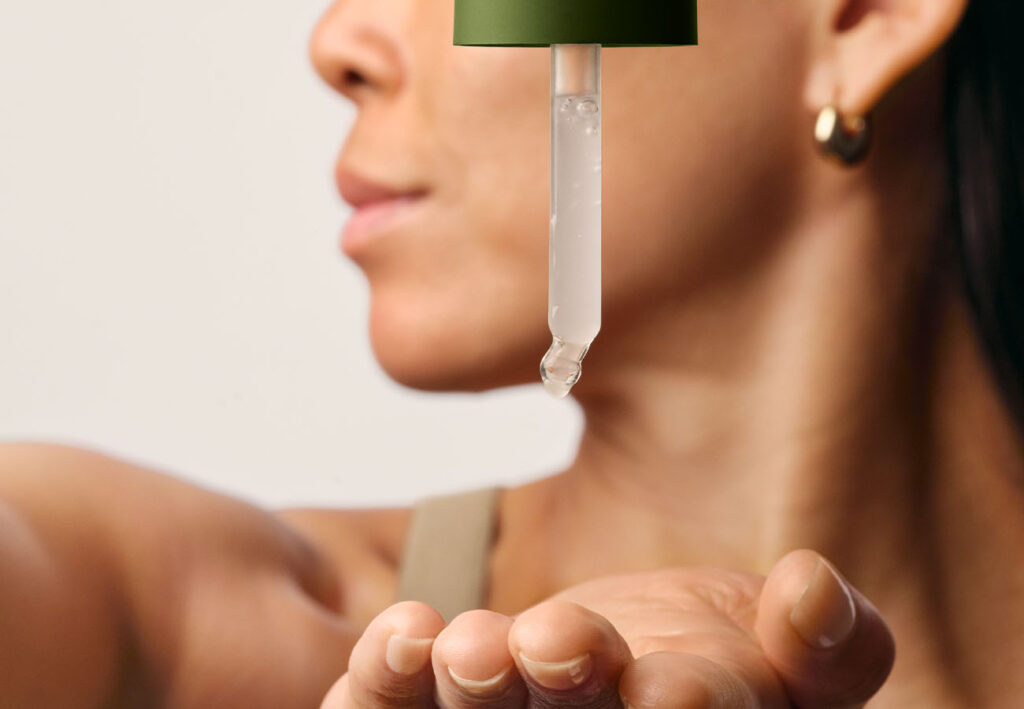What Is Face Serum?
Face serum is a lightweight skincare product that can complement the effects of a traditional moisturizer while delivering additional benefits to the skin. With a fast-absorbing formula, many face serums contain high concentrations of active ingredients.
Depending on the product and the skin type it’s designed for, these ingredients can include hyaluronic acid, vitamin C, retinol, vitamin B3, and peptides. Many people choose to use a face serum as part of their skincare routine to receive the benefits of these ingredients without overloading their skin with additional products.
Face serums are available for all skin types and can be designed to achieve a number of different skincare goals, from hydration and brightening to reducing the visible effects of aging. The products have a lighter texture and a thinner consistency than moisturizers, thanks to the smaller molecules used in their formulation. Most serums should be applied after cleansing and before moisturizing.
Choosing the Best Face Serum to Complement Your Skin Type
Because different serums offer different benefits, understanding your skin type is extra important when choosing the appropriate product. If you’re not sure what your skin type is, here’s a breakdown of the most common skin types and their determining factors.
The Best Serum For Dry Skin
Some telltale signs of dry skin include flakiness, dry patches and areas of irritation or sensitivity. Your skin may feel slightly rough to the touch, and it might tighten up after showering or washing your face.
When choosing the best face serum for dry skin, look for ingredients such as glycerin, hyaluronic acid and vitamin E. All these ingredients are known for their hydrating properties. Pairing a hydrating serum with your regular moisturizer during your nighttime skincare regimen can help lock in moisture for several hours as you rest and your skin goes into “repair” mode.
The Best Serum For Oily Skin
If your skin type is oily, it may produce more sebum (oil) than those with dry or normal skin types. Oily skin can increase the risk of breakouts and clogged pores, and your skin may have a shiny appearance.
Serums containing ingredients, such as amino acids, red algae extract and mango leaf extract, are ideal for oily skin. Amino acids may help with reducing blemish formation and achieving clear skin. Red algae extract contains soothing properties to help minimize skin irritation and discomfort. Mango leaf extract aids in controlling shine from excess oil and may help prevent blemishes.
The Best Serum For Combination Skin
Combination skin is exactly how it sounds. Your skin may have dry and oily areas. The T-zone is the area that connects your forehead and your nose, forming the shape of a “T.” People with combination skin typically have an oily T-zone and cheeks that are more prone to dryness.
Serums formulated with both oil-controlling and moisturizing ingredients work best on combination skin. Look for ingredients, such as mango leaf extract, to control oil in the T-zone and vitamin E or glycerin to balance out dehydrated areas.
The Best Serum For Sensitive Skin
Some common signs of sensitive skin include dryness, irritation and inflammation, caused by external stressors such as weather fluctuations, allergens and certain skincare ingredients. If you have sensitive skin, your symptoms may range from mild itchiness or redness to severe irritation, depending on the external trigger. People with sensitive skin types should look for serums with gentle, nourishing ingredients that help protect the skin’s barrier and soothe irritation. Glycerin and vitamin E are gentle yet effective moisturizing ingredients, while red algae extract may help calm irritated skin. Vitamin C can help to create a brighter and more even complexion. It can also protect the skin’s collagen reserves, and hyaluronic acid targets dryness.
The Best Serum For Normal Skin
Normal skin types basically refer to skin that’s well-balanced, with minimal oiliness and dryness. However, people with normal skin types may experience excess shine or dryness from time to time, particularly during periods of humid or dry weather. Environmental factors, hormonal fluctuations, excess sun exposure and natural aging can affect the skin, so normal skin types are actually considered quite rare.
Normal skin types can benefit from serums containing ingredients such as hyaluronic acid, vitamin C, red fungi extract and peptides. Hyaluronic acid draws moisture toward the skin’s deeper layers, allowing for balanced hydration levels. Vitamin C helps brighten the complexion while protecting its natural collagen reserves, and red fungi extract has been shown to promote skin firmness. Peptides are known for their brightening, skin-balancing properties.
What’s My Skin Type? Try the Tape Test
The “Tape Test” is a fast and simple solution to help you determine if your skin type is normal, oily, dry or combination. This test should be performed on freshly cleaned, towel-dried skin that’s free of skincare products or makeup; it’s not recommended for sensitive skin. For best results, wait about 20 minutes after washing your face before starting the test.
To perform the test, take a medium-sized piece of clear, plastic tape and place it over your face, from one ear and across your nose to the other ear. Allow the tape to sit on your skin for about 3 minutes. Then, gently pull it off and look at the sticky side. Here’s what the results mean:
- Normal skin: If the tape pulls off easily and the sticky side is clear, this indicates normal skin with an equal balance of moisture and sebum.
- Oily skin: Oily skin may leave a residue on the sticky side of the tape, or the tape may have trouble sticking to your skin. You might also notice that the tape slides around a bit when it comes in contact with your skin.
- Dry skin: If your skin type is dry, the sticky side of the tape may have a cloudy appearance. This is due to dry skin flakes sticking to the tape.
- Combination skin: Since combination skin can be both dry and oily at the same time, the tape may slip around on your nose and pull dry skin flakes off your cheeks.
Custom Skincare Solutions at Prose
Adding a serum step to your regular skincare routine can help increase hydration, reduce the look of dark spots, promote a bright complexion and much more. If you’re ready to take your regimen to the next level, the team at Prose is happy to assist. Prose custom face serum is designed to be the best serum to complement your unique complexion, and all products are made-to-order. To get started, take the Prose skincare consultation and create your own customized serum formula.





